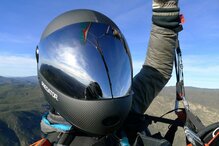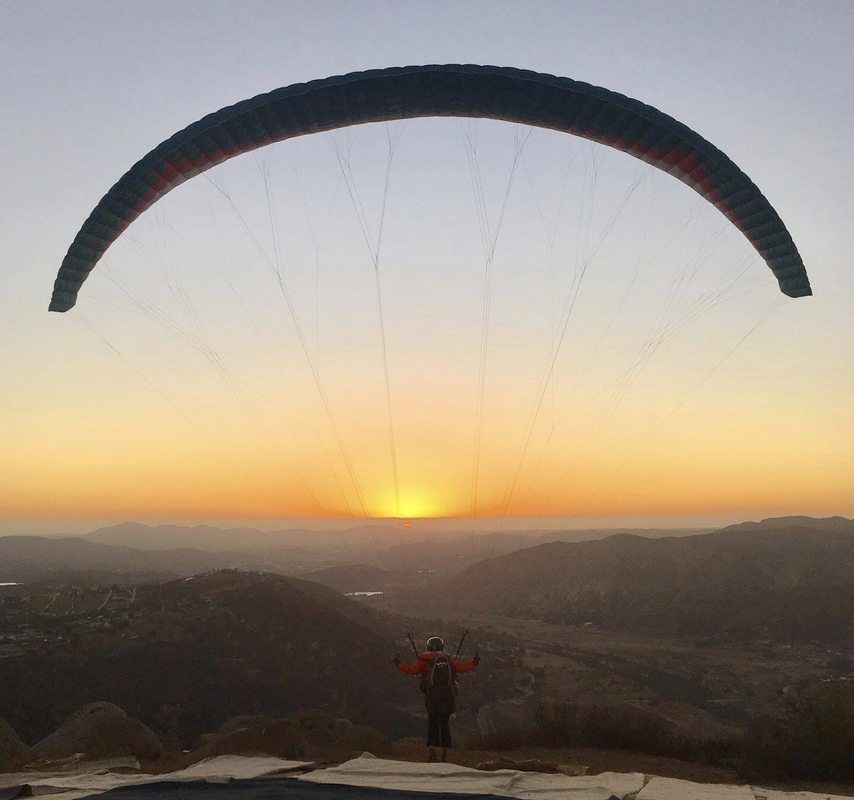| I was out kiting the other day in swirly winds and was joined by a relative newbie to the sport. As I watched them kite, I noticed a few things that suddenly gelled for me. First, that kiting (and paragliding) is an extraordinarily complex activity that pretends to be simple: Get the wing up, keep it stable overhead. Depending on conditions, that can be as easy as using just the hips to pull up the wing, or as difficult as using all 9 control inputs you have when kiting. More on those 9 inputs in a bit. | Article by Nik Hawks |
Third, that kiting in laminar flow on the coast is an excellent introduction to kiting, but mastering keeping the wing overhead in smooth air is deceptive, with little application to launching at mountain sites.
If you’re in the position of having completely dialed in kiting on the coast but have real trouble stabilizing the wing on mountain launches, here are a few things to think about, along with an excellent website to visit in order to give you an idea of where you are in your progression.
Use this idea framework to build your own understanding of kiting, and figure out what works for you!
Let’s start with what you have to control your wing.
Many beginners start with using the A’s to pull up, then focusing on the brakes. Using the 2 inputs of the brakes (Left & Right) to control your wing is just step 1 of the progression. If all you do is kite in laminar flow, you don’t need to progress beyond this.
If the brakes are 2 inputs (Left brake and Right brake), and you have 9 total inputs when kiting, let’s go through them in the order I think you should learn ‘em.
The caveat to that “order to learn” is the idea that these inputs are most masterfully used as part of a synergistic control of the wing. Think of this as less a rigid order of things to learn and more a guide to greater competency.
I’ll assume you’ll start work on all this in manageable laminar flow in order to make each input and result as clear as possible. I strongly recommend you do NOT try this out on your next mountain launch if you’ve never done it before; kiting (and paragliding in general) is far safer when we follow a gentle progression.
Ok, so you’ve got the brakes working for you, slowing down the back of the wing on the left and right sides. The next thing to start using is the A’s. Those are your 3rd and 4th inputs for control. They will speed up the wing on the leading edge, giving you a new form of input (speed vs brakes) that will be vital to controlling the wing.
When kiting in laminar flow, be relaxed about letting go of the brakes in order to grab and manipulate the A’s. In case it’s not obvious, you should not be letting go of the brakes if you have ANY issues with keeping the wing stable & overhead in laminar flow.
I know, I know, lots of instructors are yelling at me right now, “What about the hips, Nik!? Tell ‘em about the hips already!”
Hips are your 5th and 6th inputs; your left and right hip twist. Those twists of the hips, along with lifting and lowering them are how you will control your riser height and therefore wing balance when it comes to the “roll” axis.
This is best demonstrated and practiced by getting the wing to alternately kiss the ground on the left and right side while in laminar flow. Sure, you’ll use the brakes and the A’s, but once you start to include a hip twist to manage your riser tension, a whole new world of control will open up to you.
Your 7th and 8th inputs are the use of your rear risers. Rear risers control the trailing edge of your glider like your brakes, but with less authority EXCEPT when you stall the wing. Think of ‘em as a more subtle way to slow down the wing, and make sure you work with them a bunch!
I used to think of rear risers as “mega brakes”, but Chris Cote suggested not putting ‘em in the “brakes” category at all as they are far more subtle (until you stall.)
Use the time on the ground kiting to see what happens when you start to use rear risers to control that aft surface vs using your brakes. You’ll be using rear risers a ton in the future when you start to get on speed bar in the air, so get used to grabbing and using them now.
Finally, your 9th input is your weighting of the wing. This includes both the tension on the lines in general AND where you are under the wing. I left this step for last because I’m assuming you’re already able to stay centered under the wing and well weighted in laminar air.
Again, control in laminar air is our starting point. Once you’re nailing the 9 points in smooth air, find some trees to get behind so you can play with swirly turbulence. Move behind other gliders. Play tag on the ground, or have a friend yank down on your A’s. Close your eyes and see how long you can stand in one place; the list of things you can do to practice is long!
I reached out to a few folks about this article looking for feedback, since my limited time in the sport makes it pretty easy to miss something important. Here’s what they had to say:
Jocky Sanderson: “The ability to be quick at turning and loading lines is vital, but often overlooked.”
This is something I’ve seen a bunch on mountain launches. New pilots do a rear launch, get it up overhead and centered, then turn in an unbalanced and/or slow way. Mountains launches have swirly air that is unforgiving of an unbalanced or slow turn. The usual outcome is a partial collapse or otherwise missing the launch.
It is definitely worth practicing smooth, quick, and balanced turns in turbulent air at the kiting field a bunch!
Along those same lines, Mitch Riley talked about moving around under the wing and the importance of footwork. Moving yourself around under the wing in order to weight, unweight and tension or release the lines is a more advanced step of control in ground handling.
Mitch: “I tend to emphasize the importance of footwork when teaching kiting as I think proper footwork is the foundation for then adding a bunch of other skills and tools. I'd rank footwork as the #1 control input.“
Ok, so those are the 9 inputs to use while ground handling (plus Mitch’s advice to use your feet!)
Check out Andre Bandarra's Groundhandling Challenge for a ton of ideas on what you can do with your wing, and start working on all of those inputs in order to work through those exercises.
If you need further encouragement that kiting is important, check out Ziad Bassil's thoughts on the importance of kiting as part of your flying progression.
If you have any kiting observations that have been helpful for you, please comment below so we can all learn together.
See you at the kiting ground, and in the sky!
Cheers,
Nik
This article was created with the help of many paraglider pilots. A huge thanks to Chris Cote, Jocky Sanderson, Mitch Riley, and all the folks on the hill who’ve weighed in with advice and guidance. An especially big thanks to Wendy Schuss, for making me kite for 6 months before I got to fly. You know my impatience too well, WenPep! Any faults in thinking or understanding kiting that still remain are mine alone.




 RSS Feed
RSS Feed

